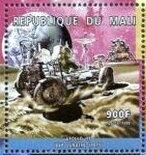Stamp: Apollo 15 (Mali 1999)
Apollo 15 (Mali 1999)
20 July (Mali ) within release Space Explorations 1999 goes into circulation Stamp Apollo 15 face value 900 West African CFA franc
| Stamp Apollo 15 in catalogues | |
|---|---|
| Michel: | Mi: ML 2275 |
| Stamp Number: | Sn: ML 1039a |
Stamp is square format.
Stamp from mini sheet of 4Also in the issue Space Explorations 1999:
- Mini Sheet - Space Events face value 4*250;
- Mini Sheet - Space Events face value 4*310;
- Mini Sheet - Space Events face value 4*320;
- Mini Sheet - Space Events face value 4*500;
- Mini Sheet - Space Events face value 4*750;
- Mini Sheet - Space Events face value 4*900;
- Stamp - Luna 6 and Lunokhod 2 face value 320;
- Stamp - Mariner 10 face value 900;
- Stamp - Neil Armstrong face value 320;
- Stamp - Pioneer 10 face value 900;
- Stamp - Robert H. Goddard face value 500;
- Stamp - Skylab 1 face value 900;
- Stamp - Surveyor 3 face value 320;
- Stamp - Theodore von Kármán face value 500;
- Stamp - Voyager 1 face value 310;
- Stamp - Yuri Gagarin face value 750;
- Stamp - "Venera 12" face value 250;
- Stamp - Apollo 15 face value 900;
- Stamp - Apollo 18 and Soyuz 19 face value 310;
- Stamp - Ariane 5 face value 250;
- Stamp - Carl Sagan face value 310;
- Stamp - Columbia face value 250;
- Stamp - Dog Layka face value 750;
- Stamp - Edmund Halley and Giotto probe face value 310;
- Stamp - Edward White face value 750;
- Stamp - Frank Borman face value 320;
- Stamp - Hermann Oberth face value 500;
- Stamp - Hubble face value 250;
- Stamp - John Glenn face value 750;
- Stamp - Konstantin Ziolkowski face value 500;
Stamp Apollo 15 it reflects the thematic directions:
An astronaut (from the Ancient Greek ἄστρον (astron), meaning 'star', and ναύτης (nautes), meaning 'sailor') is a person trained, equipped, and deployed by a human spaceflight program to serve as a commander or crew member aboard a spacecraft. Although generally reserved for professional space travelers, the term is sometimes applied to anyone who travels into space, including scientists, politicians, journalists, and tourists
A crescent shape (/ˈkrɛsənt/, UK also /ˈkrɛzənt/) is a symbol or emblem used to represent the lunar phase (as it appears in the northern hemisphere) in the first quarter (the "sickle moon"), or by extension a symbol representing the Moon itself.
A globe is a spherical model of Earth, of some other celestial body, or of the celestial sphere. Globes serve purposes similar to maps, but, unlike maps, they do not distort the surface that they portray except to scale it down. A model globe of Earth is called a terrestrial globe. A model globe of the celestial sphere is called a celestial globe
Outer space (or simply space) is the expanse that exists beyond Earth's atmosphere and between celestial bodies. It contains ultra-low levels of particle densities, constituting a near-perfect vacuum of predominantly hydrogen and helium plasma, permeated by electromagnetic radiation, cosmic rays, neutrinos, magnetic fields and dust. The baseline temperature of outer space, as set by the background radiation from the Big Bang, is 2.7 kelvins (−270 °C; −455 °F)
A spacecraft is a vehicle that is designed to fly and operate in outer space. Spacecraft are used for a variety of purposes, including communications, Earth observation, meteorology, navigation, space colonization, planetary exploration, and transportation of humans and cargo. All spacecraft except single-stage-to-orbit vehicles cannot get into space on their own, and require a launch vehicle (carrier rocket).






